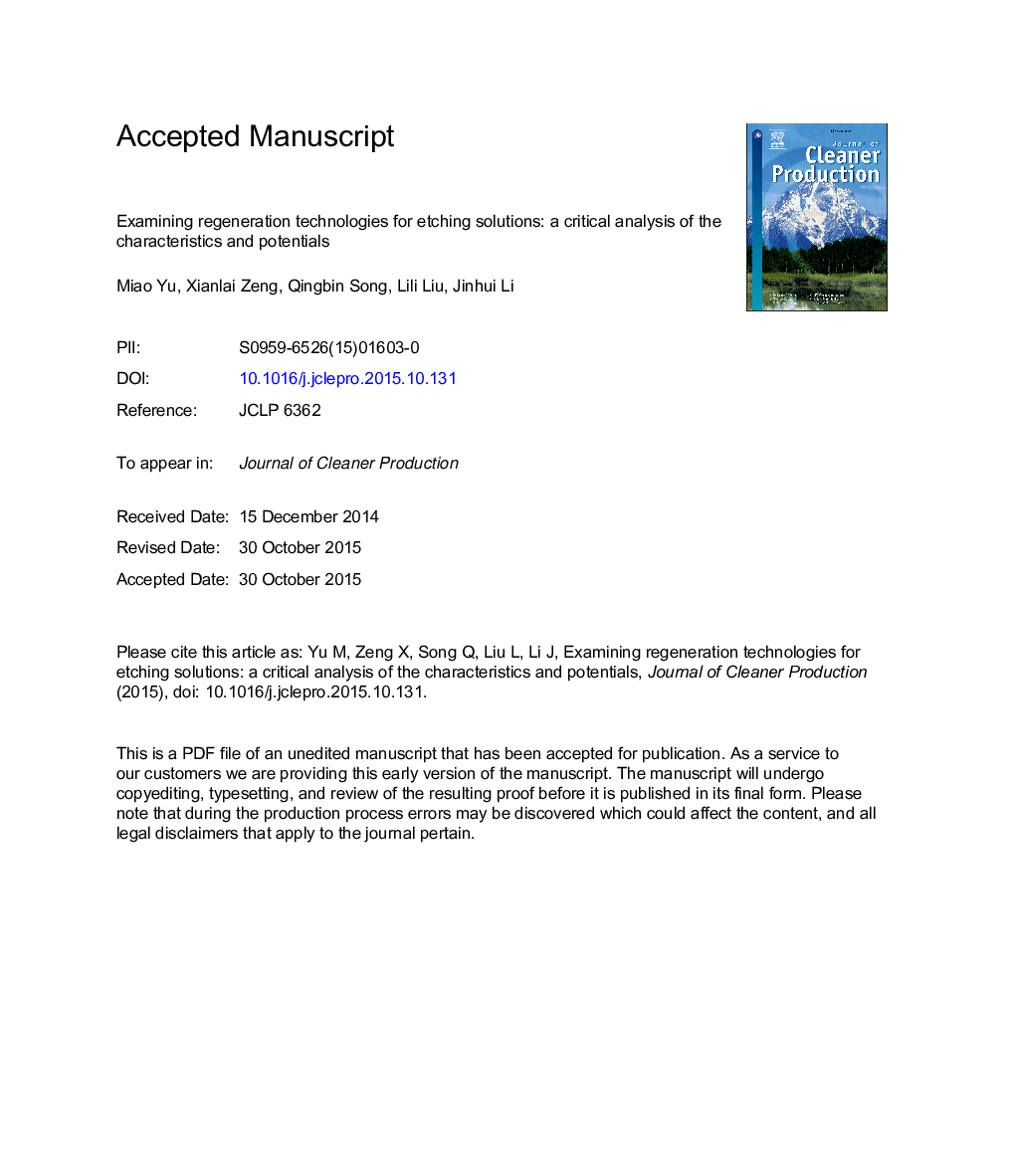| کد مقاله | کد نشریه | سال انتشار | مقاله انگلیسی | نسخه تمام متن |
|---|---|---|---|---|
| 8103072 | 1522136 | 2016 | 14 صفحه PDF | دانلود رایگان |
عنوان انگلیسی مقاله ISI
Examining regeneration technologies for etching solutions: a critical analysis of the characteristics and potentials
ترجمه فارسی عنوان
بررسی فن آوری های بازسازی برای راه حل اچ: تجزیه و تحلیل بحرانی از ویژگی ها و پتانسیل
دانلود مقاله + سفارش ترجمه
دانلود مقاله ISI انگلیسی
رایگان برای ایرانیان
کلمات کلیدی
تخته مدار چاپی راه حل اچینگ، فن آوری بازسازی، پتانسیل، مقایسه
ترجمه چکیده
در سراسر جهان، بیش از یک میلیارد متر مکعب اختراع مواد زائد از صنعت چاپ تخته مدار تولید سالانه با افزایش 15-18٪ است. امروزه روشی برای افزودن مواد شیمیایی اضافی برای درمان تعداد زیادی اکسنده زباله استفاده شده است که می تواند محصولات کم خالص را به دست آورد، اما به طور جدی محیط زیست را آلوده می کند. علاوه بر این، شرکت پردازش می تواند ارزش زیادی نداشته باشد که بر توسعه پایدار تأثیر می گذارد. در مطالعات قبلی، فن آوری های بازسازی محلول اچینگ به طور جامع و سیستماتیک مورد مطالعه قرار نگرفته است، بنابراین ضرورت جدی برای بررسی و انتخاب فن آوری مناسب برای یک زنجیره عرضه حلقه بسته است. نتایج نشان داد که راه حل اچ قبلی (مانند سولفات آمونیوم، گوگرد / اسید کرومیک، سولفوریک پراکسید اسید / هیدروژن، کلرید سدیم، کلرید فریک) باعث آلودگی شدید بدون دفع مناسب است، اما بسیاری از اچ فعلی (به عنوان مثال کلرید مس، راه حل اچ قلیایی ) پس از بازیافت فلزات سنگین از اتیلن، قابل تجدیدنظر می باشد. با توجه به آخرین راه حل های در حال ظهور، اکسیدان های مورد استفاده مانند کلر به عنوان منابع اصلی خطر حتی اگر دارای قابلیت اچینگ فوق العاده ای باشد. راه حل های فعلی اچینگ می تواند به هدف توسعه پایدار منابع و محیط زیست برسد. برای راه حل های اچری کلراید مس که در حال حاضر به طور گسترده ای مورد استفاده قرار می گیرند، روش های مختلف بازسازی وجود دارد، اما تنها دو مورد از دیگران مطلوب تر است. در میان تمام فن آوری های بازسازی، فرآیند الکترولیتی و تکنولوژی غشایی نه تنها محصولات خالص بیشتری به دست می آورند، بلکه راه حل باقی مانده می تواند تجدید پذیر باشد. در نهایت، ما روش فرایند تحلیل سلسله مراتبی را برای مقایسه تکنیک های بازسازی استفاده کردیم و دریافتیم که روش الکترولیتی و تکنولوژی غشا بهتر از سایر روش های عملکرد اقتصادی و محیطی است. این دو روش می توانند جایگزین رسوب شیمیایی شوند که صنایع تخته مدار چاپی را حفظ خواهند کرد.
موضوعات مرتبط
مهندسی و علوم پایه
مهندسی انرژی
انرژی های تجدید پذیر، توسعه پایدار و محیط زیست
چکیده انگلیسی
Globally, more than one billion cubic meters of waste etchants from printed circuit board industry have been generated annually with an increase of 15-18%. Nowadays, the approach of adding extra chemicals has been utilized to treat a large number of waste etchants, which could obtain low-pure products, but seriously pollute the environment. Furthermore, the processing enterprise cannot gain so much value that is affecting sustainable development. In the previous studies, the regeneration technologies of etching solution have not been studied comprehensively and systematically, so it is of extreme necessity to examine and choose the suitable technology towards a closed-loop supply chain. The results showed that previous etching solution (e.g. ammonium persulfate, sulfur/chromic acid, sulfuric acid/hydrogen peroxide, sodium chloride, ferric chloride) caused severe pollution without proper disposal, but most of the current etchants (e.g. cupric chloride, alkaline etching solution) can be renewable after substantially recycling heavy metals from the etchants. Regarding the latest emerging solution, the used oxidant such as chlorine is regarded as the major risk sources even if it has extraordinary etching ability. The current etching solutions could meet the goal of sustainable development of resources and the environment. For the copper chloride etching solutions that are now widely applied, there are various regeneration approaches, but only two are more favorable than the others. Among all the regeneration technologies, the electrolytic process and membrane technology not only get more pure products, but the residue solution can be renewable. Finally, we employed the analytic hierarchy process to compare the regeneration techniques and found that the electrolytic method and membrane technology are superior to other methods in the economic and environmental performance. The two methods can replace the chemical precipitation, which will sustain the printed circuit board industry.
ناشر
Database: Elsevier - ScienceDirect (ساینس دایرکت)
Journal: Journal of Cleaner Production - Volume 113, 1 February 2016, Pages 973-980
Journal: Journal of Cleaner Production - Volume 113, 1 February 2016, Pages 973-980
نویسندگان
Miao Yu, Xianlai Zeng, Qingbin Song, Lili Liu, Jinhui Li,
